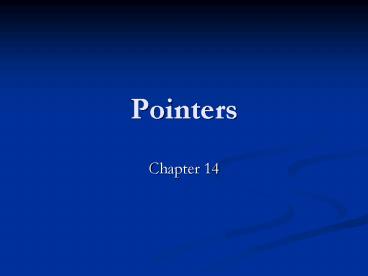Pointers - PowerPoint PPT Presentation
1 / 9
Title:
Pointers
Description:
What values of x and y is printf going to print? why? Now consider this: int main ... What values of x and y are printed here? why? Passing by Reference ... – PowerPoint PPT presentation
Number of Views:30
Avg rating:3.0/5.0
Title: Pointers
1
Pointers
- Chapter 14
2
What is a pointer?
- A pointer is a variable that holds a memory
address. - Pointers are an indirect way to access an object
and thus the use of pointers is sometimes called
indirection.
3
Defining a Pointer
- A pointer variable is defined by placing a in
front of the variable name. - long temp NULL
- char c NULL
- short a,b
- the is considered part of the variable name
during declaration. The above definition is not
the same as short a,b In this declaration, a
would be a pointer to a short, and b would be a
short. - Even though youre technically declaring youll
be storing a memory address, you still need to
specify what type of data the pointer points to. - You should always set your variables equal to
NULL at the time of declaration. By default,
theyre given a random address and use of the
pointer could cause data corruption and will most
likely cause a program and/or OS crash.
4
Using Pointers
- To set a pointer to point to an already existing
variable, you need to use the address operator, - short a77short tempNULLtemp a
- temp now holds the address to variable a.
5
Using Pointers
- To modify or retrieve the data that a pointer
points to, you need to use the dereference
operator, - short a77short tempNULLtemp a //set
temp to point to atemp 2 //set the stuff
being pointed at by temp to 2printf(ad
\n,temp) //prints the value of temp
printf(ad \n,a) //prints the value of a - Essentially, in the above example, using temp is
equivalent to using a directly. Using variables
directly is much faster than using them
indirectly through pointers, so you should use
them directly whenever possible.
6
What if .
- What if in the last example, I had forgotten to
use the dereference operator when using temp? - temp 2
- temp2 would have caused temp to point to memory
address 2. Any use of temp after this would
cause either a crash or data corruption. - printf(ad \n,temp)
- printf(ad \n,temp) would have printed the
memory address of temp rather than the data being
pointed at by temp.
7
Pointers Functions
- Consider this code
- int main( )short x 1, y2swap(x,y)printf(x
d, yd,x,y)return 0int swap( short a,
short b)short temp aa bb tempreturn
0 - What values of x and y is printf going to print?
why?
8
- Now consider this
- int main( )short x 1, y2swap(x,y)printf(
xd, yd,x,y)return 0int swap( short
a, short b)short temp aa bb
tempreturn 0 - What values of x and y are printed here? why?
9
Passing by Reference
- Using pointers to pass data to a function is
called passing by reference. It allows you to
manipulate the data of the calling function from
within the called function which normally would
be unavailable. It effectively allows you to
return multiple values back to the calling
function.































